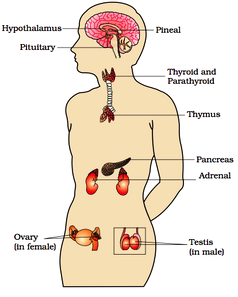List of Ductless Glands present in the Human Body
Ductless glands which are also known as internally secreting glands or endocrine glands secrete their products or hormones directly into the blood stream in response to instructions from the brain. Let us find out how these ductless glands functions, where they are located in the human body, what they secrete.

Glands are the organs of the human body which manufacture some liquid products which are secreted internally or externally from the cells. Mainly there are two types of glands namely ducted glands and ductless glands. Ducted glands secrete their products through well defined ducts like liver, salivary, sweat glands etc. Whereas Ductless glands which are also known as internally secreting glands or endocrine glands secrete their products or hormones directly into the blood stream in response to instructions from the brain. The blood then carries them around the body where they control internal chemical processes. Hence they are linked with the nervous system and also with the circulatory system and their secretions are known as hormones or enzymes. This article deals with the ductless glands, where they are located in the body, secretion and function.

Source:www.qph.ec.quoracdn.net.com
List of Ductless Glands present in the Human Body
1. Thymus
Located: Gland like structure situated in front of the trachea behind the top of the breastbone.
Function: In early childhood plays some part in building resistance (immunity) to disease and physical development.
2. Thyroid
Located: A two-lobed gland found in all vertebrates located in front of and on either side of the trachea.
Secretion: It secretes thyroxine which contains 65% iodine. Rate of production is regulated by the pituitary gland.
Function: It regulates metabolism. Deficiency causes dwarfness in children called cretinism and myxodema or gill’s disease in adults. Its deficiency also causes goitre which is the enlargement of thyroid gland.
3. Para-Thyroid
Located: Four, small kidney-shaped glands that lie in pairs near or within the lateral lobes of the thyroid glands.
Secretion: It secretes parathormone.
Function: Raise the level of calcium in the blood. Its deficiency causes tetany. It regulates calcium in blood and helps in growth. Removal of these glands may cause death.
Do you know which Human Body Organs can be donated
4. Prostrate
Located: A gland present in males surrounding urethra at the neck of the bladder. The urine passes through it.
Secretion: Prostatic secretion is mixed up with sperms and other fluids to make up the semen.
Function: Secretion is essential to the general functions of the human body related to blood pressure and sexual potency. In men above 50 enlargement of this gland is common but if disorder exists then surgical removal is required.
5. Gonads:
Located: These are the reproductive glands present in the ovaries of female and testes in males.
Secretion: Gonadotrophins
Function: Relates to the reproductive system of the body, increases secretion of sex hormones.
6. Adrenal
Located: Two small dissimilar glands, one above each kidney, consisting of cortex and medulla.
Secretion: Cortex secretes corticosteroid and medulla secretes sex hormones including adrenaline and cortisone.
Function: Causes acceleration of the breath, contraction of small blood vessels, dilation of the pupil and increases metabolic rate. Also causes heightened emotion and a sudden increase in physical strength, as during fear or anger, controls sexual growth and almost all functions of the human body. It also regulates blood pressure and function of the heart. Its rise causes Addison’s disease.
7. Pancreas:
Located: Soft irregular 15 cm long gland lying near the stomach.
Secretion: Secretes pancreatic juice into the duodenum and contains the Islets of Langerhans, produces insulin, a clear secretion alkaline in nature containing enzymes.
Function: Aids in digestion of proteins, carbohydrates and fats. Its failure results in diabetes.
8. Pituitary
Located: A small oval shaped gland attached to the base of the vertebrae in the brain which is also known as hypophysis.
Secretion: The anterior pituitary gland produces the following hormones and releases them into the bloodstream: adrenocorticotropic hormone, which stimulates the adrenal glands to secrete steroid hormones, principally cortisol, growth hormone, which regulates growth, metabolism and body composition.
Function: It is also known as Master Gland which controls the endocrine glands and influences growth and metabolism. The hormones secreted by it control mental, sexual and physical growth of the body. Deficiency causes dwarfism. An excess of it results in much increased body growth called Acromegaly.
From this article we come to know about the various ductless glands, their secretions, locations and functions.